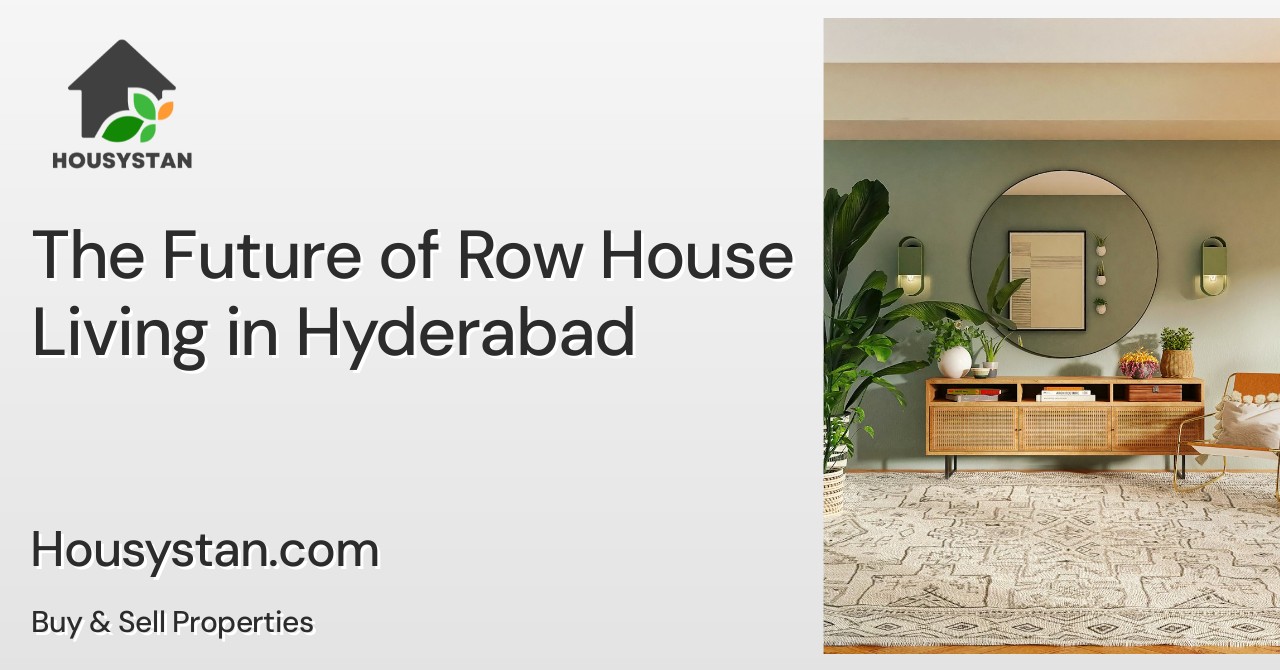The Future of Row House Living in Hyderabad
Read latest blogs and articles from Housystan

The Information mentioned here was last updated on:
11/12/2025The Future of Row House Living in Hyderabad
Hyderabad, the bustling capital of Telangana, has gained a reputation as an emerging hub for IT and business sectors, drawing people from across the country. With rapid urbanization underway, the city's real estate market is witnessing transformative shifts, particularly in terms of housing preferences. One of the most intriguing trends is the rising interest in row houses. But what does the future hold for row house living in this vibrant city?
Why Row Houses?
- Verified Tenants/Buyers
- Unlimited Property Listing
- Zero subscription/charges fee
Row houses, often considered a middle ground between apartments and independent villas, bring the best of both worlds. These homes offer privacy, similar to standalone properties, while also fostering a sense of community akin to apartment lifestyles. Let’s dive into why row houses are catching the eyes of Hyderabad's residents.
A Blend of Privacy and Community
Row houses offer a unique combination of privacy and community living. Residents can enjoy their personal space without feeling isolated from their surroundings. The design and layout of these homes often include small private gardens or terraces, adding a touch of nature without the hassle of large-scale maintenance.
Affordability and Space
Many people who are in the market for new homes are increasingly valuing both affordability and ample space. Row houses hit this sweet spot by being more cost-effective than villas and offering more room than typical apartments. Families who desire a garden or a backyard for their children can find it in row houses without breaking the bank.
Design and Aesthetic Appeal
The architectural design of row houses often reflects modern trends, which appeal to the aesthetically conscious homebuyer. With options to customize interiors and stylize exteriors, these homes maintain a contemporary charm. This adaptability also means each row house can potentially reflect the owner’s personality and taste.
Emerging Preferences in Urban Living
As Hyderabad continues to expand, people are looking for residences that offer peace without making them feel secluded. Modern row house projects are often strategically located to provide easy access to major urban centers, workplaces, and schools, making them ideal for busy professionals and families alike.
Proximity to Nature
An important factor driving the demand for row houses is their ability to harmonize with nature. Many new projects prioritize green living spaces, with parks, tree-lined streets, and even nature trails included within the community’s boundaries. This focus on integrating natural elements caters to a growing demographic that values environmental sustainability.
Infrastructure and Urban Planning
The demand for row houses in Hyderabad is further influenced by ongoing developments in urban infrastructure. Enhanced roadways, public transportation systems, and connectivity improvements are helping suburban areas become more accessible. Row house communities, which are often located in these suburban belts, benefit from these advancements.
The Changing Real Estate Landscape
Several factors are reshaping the real estate market in Hyderabad, paving the way for row houses to become a mainstream housing choice. These include governmental initiatives, the influence of the IT boom, and the influx of young professionals seeking long-term investments.
Innovation and Technology in Row Houses
Both technology and innovation are playing pivotal roles in the evolution of row house projects. Smart home features, such as automated lighting, security systems, and energy-efficient appliances, are becoming standard offerings in newly developed row houses. These technological enhancements not only appeal to tech-savvy buyers but also add significant value to the properties.
Government Policies and Incentives
The support from government policies aimed at boosting affordable housing projects is encouraging for developers focusing on row house projects. Tax incentives, reduced interest rates for home loans, and expedited approvals for green developments are a few measures that are likely to increase the construction and purchase of these housing units.
Social Dynamics and Community Living
The demographic makeup of Hyderabad is rapidly evolving, with more nuclear families and single professionals choosing to settle in the city. For these groups, community living offers advantages such as shared resources, organized social events, and cohesive neighborhood watch systems, all of which are characteristic of row house communities.
Row Houses vs. Other Housing Options
While there are multiple housing options available, it's clear that row houses offer a unique proposition. Unlike multi-level apartment complexes, which can sometimes lead to a feeling of disconnect among residents, row houses allow for better integration between neighbors. They provide an ideal setting for relationship-building and community support.
Eco-Friendly Developments
With increasing awareness of environmental conservation, there is a clear trend towards eco-friendly housing. Developers are incorporating sustainable practices in the construction of row houses, using materials and designs that reduce carbon footprints. These efforts align with the growing public interest in protecting the environment while enjoying the comforts of modern homes.
Conclusion-less Exploration
Like any future-focused discussion, the shift towards row house living in Hyderabad invites continuous dialog and exploration. Monitoring the trends, technological advances, and societal changes will provide further understanding as developers and homebuyers navigate the evolving housing landscape in Hyderabad.